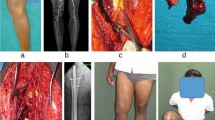Abstract
To describe the different presentations, diagnostic evaluations, management, and outcome of late complications of vascular trauma of the extremities (LCVTE) in civilian practice. All the patients with LCVTE who reported at the Yaounde General Hospital from January 2010 to December 2019 were included. Patients presenting with acute vascular injuries, neck vessel injuries, and iatrogenic lesions or late complications of vascular access for hemodialysis were excluded. All cases were evaluated with ultrasound and/or computer tomography and managed with various open vascular surgical techniques and their results were assessed. Fifteen patients with 17 LCVTE underwent various vascular repairs. There were 2 women and 13 men. The mean age was 30.28 years (median 22, range 8 months to 54 years). The time interval between injury and presentation in the hospital was 3 weeks to 15 years with a mean of 3 months (median 6 months). Penetrating injuries secondary to stabs were the commonest cause in 94.11%. Lower limb vessels were affected in 12/17 (70.58%), with the superficial femoral artery being the most frequently involved artery in 6 (35.29%) cases. Sixteen (94.11%) patients presented with pseudoaneurysm, 1 with solely traumatic arteriovenous fistula. Some pseudoaneurysms presented with complications such as infection (2 cases), bleeding (3 cases), and rupture with hypovolemic choc (1 case). The only non-vascular injuries associated were 1 brachial plexus injury and 1 fracture of the distal femur shaft. For the 15 lesions that underwent surgery, the most frequent surgical techniques used were simple suturing (66.66%) followed by resection and end-to-end anastomoses (26.66%). Unfortunately, one postoperative mortality was registered. After a follow-up from 6 months to 10 years, no late complications were detected (no recurrence, no wound infection). Only the patient with the brachial plexus injury ended up with a flail limb that did not improve and the patient with a femoral fracture with a shortening of the limb. Penetrating wounds secondary to stabs were the main injuries and pseudoaneurysm was the most common late complication. Ameliorating the management environment could reduce morbidity.


Similar content being viewed by others
Data Availability
The datasets used and/or analyzed during the current study are available from the corresponding author on reasonable request.
References
Faulconer ER, Branco BC, Loja MN, Grayson K, Sampson J, Fabian TC, et al. (2018) Use of open and endovascular surgical techniques to manage vascular injuries in the trauma setting: a review of the American Association for the Surgery of Trauma PROspective Observational Vascular Injury Trial registry. J Trauma Acute Care Surg 84:411–417
Fokou M, Chichom MA, Eyenga VC, Guifo ML (2011) Ngo nonga B, Bayebeck J, et al. Les traumatismes vasculaires périphériques en pratique civile: A propos de 41 lésions opérées au Cameroun. J Chir Th Cardiovasc 15:145–149
Kedir M, Bekele A (2004) Surgery of traumatic peripheral arterial injury with delayed transfer during the E-thio-Eritrean War 1997–2000. East Cent Afr J Surg 9:19–23
Siddique MK, Shahid MS, Irfan M, Ahmad N (2014) Missed vascular injuries: presentation and outcome. J Coll Physicians Surg Pak 24:428–431
Huseyin S, Yuksel V, Sivri N, Gur O, Gurkan S, Canbaz S et al (2013) Surgical management of iatrogenic femoral artery pseudoaneurysms: A 10-year experience. Hippokratia 17:332–336
Wahlberg, Olofson P, Golstone J (2007) Vascular injuries in the leg in Emergency Vascular Surgery: a practical guide. Berlin Heidelberg, Springer Verlag, pp 101–117.
Lönn L, Delle M, Karlström L, Risberg B (2005) Should blunt arterial trauma to the extremities be treated with endovascular techniques? J Trauma 59:1224–1227
Danetz JS, Cassano AD, Stoner MC. Ivatury RR, Levy MM (2005) Feasibility of endovascular repair in penetrating axillosubclavian injuries: a retrospective review. J Vasc Surg 41:246–225.
Markovic MD, Cvetkovic SD, Koncar IB, Dragas MV, Markovic DM, kukic BP et al. (2019) Treatment of pediatric vascular injuries: the experience of a single non-pediatric referral center. Int Angiol 38:250–255
Author information
Authors and Affiliations
Contributions
Both authors contributed to preparing the manuscript and patient management. MF finalized the manuscript and has the overall responsibility.
Corresponding author
Ethics declarations
Ethics Approval and Consent to Participate
This study was accorded institutional ethical approval by the local ethics committee of Yaounde General Hospital.
Consent for Publication
The photos presented here received the consent of both patients.
Competing Interests
The authors declare no competing interests.
Additional information
Publisher’s Note
Springer Nature remains neutral with regard to jurisdictional claims in published maps and institutional affiliations.
Rights and permissions
About this article
Cite this article
Fokou, M., Teyang, A. Late Complications of Civilian Vascular Injuries of the Extremities in Cameroon. Indian J Surg 84, 755–759 (2022). https://doi.org/10.1007/s12262-021-03076-7
Received:
Accepted:
Published:
Issue Date:
DOI: https://doi.org/10.1007/s12262-021-03076-7




